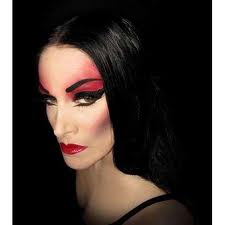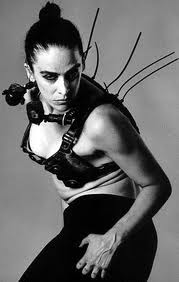By angsang
Diamanda Galas: Feminist Witch, Feminist Bitch
Introduction to the Text:
Diamanda Galas is an American avant-garde artist of Greek descent who has been considered one of the most important artists of our time. She is a pioneer of a new vocal music style that seeks to embody the most extreme states of consciousness. Galas’s radical approach to music is such that she “ doesn’t care if the lyrics are heard clearly; she only needs to sing the ‘id’ subtext, because she’s already swallowed the song text so wholly into her expressive DNA that the meaning is clear gesturally” (Grant). Galas dares to transgress against the common artistic imperative to constrain the intensity of one’s emotions within established musical structures that, while emotive, only allow one’s art to represent, but not to be the thing itself.
Galas is classically trained in opera and in jazz and was a musical prodigy early in life. In her early years as an adult artist, she did improvisational work with artists in New York but made her performance debut as an opera singer in 1979. She played the lead in Vinko Globokar’s Un Jour Comme un Autre and continued to do classical performances until she focused her energies on rock music and the development of a new vocal aesthetic. Galas’s distinctive style that I explore in this paper first emerged with her performance of “Wild Women with Steak Knives” and then with the album, “Litanies of Satan”. For Galas, “Wild Women with Steak Knives” was a “kinesthetic representation of the mind diffracted into an infinity of crystals… .the subtractive synthesis of mental entropy into various bands of absolute and mere schizophrenia” (Galas, 61). Galas maintains that this attempt to embody mental diffraction with the voice required:
“a huge repertoire of vocal sound at one’s disposal as well as a completely elastic vocal ability, which enables the rapid navigation through these timbral elements. This is certainly not a new idea, but the absolute accuracy, the absolute detail I am referring to requires a virtuosity, a versatility with the instrument that has not been yet approached. The most minimal or the most maximal increment of timbral change over the smallest unit of time is required and, in many ways, resembles what is attempted in subtractive synthesis of white noise, wherein highly specified pitch/’timbre bands may be heard suddenly alone, in quick succession, or simultaneously. The question here is not one of a simplistic development of vocal virtuosity. Rather, it involves a redefinition of a most accurate sonic representation of thought via the most accessible, direct, and sophisticated music-making apparatus” (Galas, 62).
Galas’s interview in Angry Women occurred in 1991, about 10 years after she first came out with “Wild Women with Steak Knives” and “Litanies of Satan”. Angry Women includes interviews with some of the leading feminist thinkers of the time period who were notable for their radical and outraged approach to the injustices committed against women. In this interview, Galas elaborates on her feminist politics and how it relates to her artistic outlook. It is apparent from Galas’s radical views, that she developed her radical feminism within the context of the second wave feminist movement in the 1970s. This new era of feminism was interested in the intersection of the personal with the political and how this intersection perpetuated gender hierarchies in the everyday lives of women. Second wave feminists recognized that the political rights gained during feminism’s first wave were meaningless unless the social and private roots of women’s oppression were addressed. Thus, second wave feminism had a particular interest in sexual politics. The bedroom was suddenly open to feminist critique and women were beginning to speak of themselves as sexual beings with subjectivity, autonomy, and agency. In Angry Women, it is clear that sexual politics are central to Galas’s feminism. As will be elaborated upon later, Galas demands that women reclaim sexual power, by reversing sexual power dynamics so that women have power over men. Her misandry is evident. For example, she says “I have an allergy to ‘male genius’. If I listen to a man talk about his work for more than 2 minutes, I get supremely bored… I can certainly understand why lesbian separatist concepts evolved. So ‘male genius’ is something I have to rail against, because I feel it, I understand it-and I’m not interested” (Juno, Andrea, Vale, 17) It is also evident though, that while her radical feminism may have been crucially formed by seventies feminism, she also draws upon the female, punk rock aesthetic of the nineties. In this paper, I will examine pictures of Galas as well as videos of Galas’s performances to analyze her gender performance in juxtaposition with the interview she gave to Angry Women. I argue thus: Diamanda Galas’s gender performance in terms of appearance and vocals on stage uses ugliness as a strategy of resistance against the violence of patriarchal cultural representations of femininity. To begin, I mean to clarify how I define ‘ugliness’ as a general concept before I delve into the specifics of Galas’s performances. Gertrude Stein’s Composition as Explanation is useful to define ugliness and to demonstrate how it is transgressive.
Ugliness in Composition as Explanation
Stein argues (if it can be said that she argues anything in this text!) that nothing changes from generation to generation. Eras are “compositions” in the sense that “the only thing that is different from one time to another is what is seen and what is seen depends upon how everybody is doing everything. This makes the thing we are looking at very different and this makes what those who describe it make of it, it makes a composition, it confuses, it shows, it is, it looks, it likes it as it is, and this makes what is seen as it is seen. Nothing changes from generation to generation except the thing seen and that makes a composition” (Stein, 407). The elements that give an era it’s character and sensibilities are not fundamentally new they are only newly salient. Also, the way in which people understand or practice these elements are determined by “those who describe it” and what they “make of it”. Thus, discourse and changes in cultural emphasis determine the composition of an era, the word composition implying something that is prepared and constructed. And for Stein, anything really new in society is extrinsic to the established modern composition because anything created in sync with modern sensibilities participates in communal constructions. And it is for this reason that she describes anything ‘classic’ as being ‘beautiful’. She writes “the first rate work of art becomes a classic because it is accepted the only thing important from then on to the majority of the acceptors the enormous majority, the most intelligent majority of the acceptors is that it is so wonderfully beautiful. Of course it is wonderfully beautiful, only when it is still a thing irritating annoying stimulating then all quality of beauty is denied to it” (Stein, 408). According to Stein, finding something beautiful and enjoyable (certainly not the common experience when listening to Galas’s music) involves being indolently entrenched in the communal soul of your time period, re-enforcing it’s sensibilities, ethos, and aesthetics by categorizing what is familiar and unchallenging ‘beautiful’ and what is “irritating, annoying, stimulating” ‘ugly’. The reflexive nature of finding a work of art beautiful (because it re-enforces established tastes) seems an inevitable consequence of being social animals that revel in the security of our communities and is also indicative of our desire to identify with them. In this way, I wish to define Galas’s use of the ‘ugly’ as transgressive because it doesn’t participate in communal constructions, and thus is anti-social. Galas’s appearance and her vocals on stage defy gender norms in terms of feminine ‘prettiness’ and passivity in order to resist the violence of patriarchal constructions of femininity.
The ‘Ugliness’ of Gala’s Appearance On Stage and in Print:
Galas’s image on stage and in print borrows from the female, punk rock aesthetic in that she juxtaposes images of ‘prettiness’ with images of violence. However, unlike female punk rockers like Courtney Love who “expose the alienation and ‘messy’ interior of the female body exacted by its violent over-mythification” and style themselves like “’Kinderwhore [s]’; … ‘a child-woman, fucked up Lolita, innocence disturbed. It’s a potent, one the edge image which toys with vulnerability and power [and] hints at a ‘rape victim’ look (Raphael 1995, xxvi)” (Eileraas,128),Diamanda Galas projects nothing but threat, strength, and power. However, both female punk rockers and Diamanda Galas use ugly in their appearances in the media and on stage in order to contest patriarchal constructions of femininity. Female punk rockers play with vulnerability and power in order to reveal the damage done to women’s bodies as a consequence of patriarchal notions of ‘prettiness’ that objectify and hyper-sexualize women and that also render their bodies ‘rape-able’. One way they contest this construction is by confronting taboo features of female sexuality such as masturbation and sexual fluids, thereby re-claiming female sexual subjectivity, re-positioning women as sexual agents who are not alienated from their bodies or made ashamed of them. One performer pulled her “tampon out of her vagina and hurled it in to the audience. However outrageous, [this] action[ ] can be read as feminist for [its] brash evocation of the ‘improper’, ‘unclean’, below-the-belt femininity” (Eileraas, 129),revealingthe messy interior of female bodies that is deemed disgusting because it does not please or sexually titillate the male gaze. By contrast, Galas does not present herself as sexually vulnerable or battered in any capacity. She manipulates patriarchal constructions of ‘prettiness’ and sexual appeal in order to claim power and resist their damage.
Make-up and tight clothing are generally associated with feminine ‘prettiness’. The logic of traditional make-up is to imitate the state of sexual arousal on the face. Blush and lipstick are meant to mimic the flush that comes with the rush of blood, eyeliner and mascara are meant to imitate the slight plumping of lashes that also comes with the rush of blood, and darkened eyelids are also meant to mimic the very slight darkening of one’s eyelids that also occurs with arousal. Thus, traditional make-up is meant to hyper-sexualize. Tight or revealing clothing is meant to display the body, often connoting availability and vulnerability (which is not to say tight clothing is necessarily disempowering, but only that with women this is often the social connotation of this aesthetic). Galas wears make-up frequently in her performances and pictures. However, Galas’s make up is often garish, giving her face a pale, deathly, or menacing look. She does not wear make-up to look attractive. Galas adorns her face in ways that do not highlight her sexuality but that connote severity, threat, and perhaps even the war paint of tribal societies (note, this is in contrast to the battered make-up look of female punk artists). Galas dares you quite literally to fuck with her.
Galas also wears tight or revealing clothing. However, the combination of her make-up, expressions, poses, as well as the kinds of props she uses does not present her as being vulnerable or available. Rather, Galas projects power. For example, in Angry Women, Galas is pictured wearing a tight, leather crop top with tight leather pants. However, she is also holding a gun (Juno, Andreas, Vale, 21). In the same text, Galas is also depicted with a torn dress, breasts exposed as copious blood runs down her body (Juno, Andreas, Vale, 16). But Galas does not look like a bloodied victim, she looks like a naked, satanic victor, body running with the blood of her victim. This violent image does not project Galas’s naked body as vulnerable. Rather, her body becomes threatening, murderous. Any attempt at sexual violation, perhaps elicited by her nakedness, will be met with death. Interestingly, male nudity or shirtless-ness often projects power rather than vulnerability. It implies strength, comfort with one’s physicality, sexual aggression, and at times, sexual threat. This is rarely the case for women. But, Galas appropriates the male prerogative to be nude/wear tight or revealing clothing and to at the same time be powerful and even sexually menacing. Diamanda’s ugly gender performance is highly anti-social because she subverts normative, patriarchal constructions of pretty femininity that are a part of the modern composition of her time period. For Galas, ‘beauty’ in the Steinien ‘classical’ sense would render her powerless and passive.
‘Ugliness’ in Galas’s Vocal Performance:
One has never heard anything like Diamanda Galas’s vocal performance. It screeches, howls, babbles and seems to come from some dark, diffracted, demon recess of the soul. It is shamanistic in character and, for some, deeply disturbing. We can see in the character and effect of Galas’s vocal performance the unique politics of her radical feminism. In an interview in Angry Women, it is clear that Galas’s feminism calls women to take power, not ask for it. She says “its like: to some women it is considered a ‘bad vibe’. We’re conditioned to the idea that if someone fights back – well, that’ll bring you ‘bad karma’. We’re conditioned to this idea that if you have a gun, you’re inviting trouble” (Juno, Andrea, Vale, 22). She says, “women need to think of themselves as predators rather than prey” (Juno, Andrea, Vale, 8). And it is precisely this call to forcibly claim power that is so empowering but also so deeply problematic about Galas’s feminism. There are overtones of violence and disdain for men in Galas’s interview. She calls women to commit sexual violence against men, to reverse the power dynamics that would objectify them and make them sexually vulnerable. Galas says, “I really wanna fuck men in the ass. I want to break the flesh, too and exorcise my violence on them to show them just how much I love them!” (Juno, Andrea, Vale, 11). And she notes “Some men get angry because they think I view them just as sex objects. But I say, ‘You don’t need to read to me – I can read. And as for conversation-I can get that from my friends. So you should feel lucky that you at least have this service you can offer me” (Juno, Andrea, Vale, 15). It is interesting, however, that Galas says explicitly in the interview that she does not support non-consensual sex. Galas wishes to exercise sexual violence in a consensual relationship. However, her disdain for men is clear. She tells women that if they “want subordinates, [they can] fuck a man in the ass” (Juno, Andrea, Vale, 17). This aspect of female perpetrated sexual violence manifests in her vocal performance, whose sound is akin to an invasive and penetrative attack. Furthermore, Galas’s vocals appear to be a particularly female/feminist method of counter-discourse against patriarchal constructions of meaning and modes of communication.
Here are links for examples of Diamanda’s performance and vocals:
https://www.youtube.com/watch?v=f0AIjnQ8t30
https://www.youtube.com/watch?v=LEKuX8arORc
In her article, Witches, Bitches, and Fluids, Karina Eileraas describes the way in which female punk rockers use vocal ugliness as a method of feminist discourse. Galas uses her voice in very similar ways. Eilerass describes the animalistic screeching, howling, and wailing of punk girl-bands as politically and socially transgressive. In a culture where women are conditioned to be silent, to soften their voices, and where women are left voiceless in situations like domestic abuse or rape, these women scream. The ugly vocals of both Galas and female punk rockers proclaim a “substantial feminist presence” (Eileraas, 125) that will not be silenced, and that may also be a conduit for the collective scream of abused, enraged women that were/are silenced. Furthermore, “the ugly voice also constitutes a form of revolt against the grammar and syntax of phallogocentrism and, arguably, a step toward a specifically ‘female’ language… The ugly sounds and incoherent babble of girl rockers disrupt ‘language’ as we know it. They operate on the poststructuralist premise that language speaks through us, through our bodies, history, and culture-we do not just speak it or, least of all, own it. As such, girl bands’ voices represent ‘selves’ that are not always intentional, knowable, or visible to themselves.; … [they use] nonsense as… a margin from which to contaminate the patriarchal symbolic center” (Eileraas, 127). To reject and damage language in the way Galas and female punk rockers do can be a very powerful act of rebellion. These women refuse to allow supposedly patriarchal constructions of meaning to dominate or obscure the “not always intentional, knowable, or visible” aspects of their discontent or of their being which they seek to express, these aspects being expressible only as nonsense because of the patriarchal symbolic center of language.
The raw, untamed way in which Galas uses her vocals combined with the nature of the phenomena of sound contribute to the penetrative nature of Galas’s performances. In Millie Taylor’s article Exploring the Grain: The sound of the voice in Bruce Nauman’s Raw Materials, she posits that because sound issues from the body, vocal communication also transmits empathetic information about the vocalist’s internal state to the listener. Vocals affect people’s understandings of their bodies in space such that “Through the impact of vibrations on the receiving body, sound is perceived as a gesture that is impossible to avoid… with unique possibilities to exchange empathetic and embodied knowing” (Taylor, 289-290). Furthermore, vocals “create sounds that are of [one’s] body… the sounds [one] makes are part of [one’s] identity” (Taylor, 291). Vocal noises can be an intimate sharing of bodies and internal states that act upon listener bodies through the listener ears and through atmospheric vibrations. However, when Diamanda Galas screeches, babbles, and wails with satanic venom, her ugly sounds are invasive because for most listeners they are unwelcome and inescapable. This vocal method seems to echo Galas’s impulses toward violation that were apparent in Angry Women. Furthermore, “Galas claims to have trained herself to use her voice as a gun-presumably as protection against, and response to, violation” (Eileraas, 127). And so it may be that Diamanda’s vocals that speak the improprieties of the body, the diffracted, embodied knowing of an abused female experience but may also be a violent threat against any further attempts at violation, even committing a violation of it’s own. And though physical or sexual violation may not be addressed in every song she makes, they do appear to be one of her primary drives for expressing herself in the way that she does. Thus, Diamanda’s ugly vocal gender performance is highly anti-social because she subverts normative, patriarchal constructions of who has sexual power and who has the right/ability to violate.
The Carnival in Galas’s Performance:
Lastly, I wish to briefly discuss the presence of the carnival-esq in Galas’s gender performance. For Mikhail Bahktin in Rabelais and his World, carnival was the “nonofficial, extra-ecclesiastical, and extra-political aspect of the world, of man, and of human relations… [a] two world condition” (Bahktin, 8). Similarly, Galas’s performances create an alternative reality where femininity is performed in a way that transgresses against normative, patriarchal constructions of feminine prettiness, passivity, and sexual vulnerability. But, I argue that the carnival-esq aspect of Galas performances both does and does not revive and renew institutional structures as did carnival in medieval Europe. In medieval Europe, the double life of carnival was a kind of socially sanctioned transgression that re-affirmed institutional structures by temporarily suspending hierarchies in order to renew them. Galas means to destroy the violence of institutionalized patriarchy in her creation of an alternative reality, in calling women to create an alternative reality where they are empowered to defend themselves against men with violence. And certainly while Galas’s call to female perpetration of violence is deeply problematic, it is refreshing in that it calls women to claim power, to act boldly, loudly, and to vent fury at the violence committed against their collective bodies and souls. In this way, Galas’s gender performance seeks to incite the destruction of oppressive hierarchies. Galas appropriates patriarchy’s violent means for feminist ends. And because Galas wants to re-instate a new gender hierarchy where women have power over men and where women commit the same acts of violence that men use against them, she renews the institutional structure of patriarchal violence. Thus, the carnival spirit both is and is not a part of Galas’s performance and transgression.
Conclusion:
Understanding Diamanda Galas’s radical feminist ideology and punk rock influences helps us contextualize her gender performance on stage and in the media. Ultimately, her use of ugliness as a strategy of resistance manifests itself as violence. But like the Sirens of Odysseus, Galas’s song is both alluring and repulsive. Her ugliness is almost beautiful, a sentiment of which I’m sure Gertrude Stein would approve.
Works Cited
Bakhtin, M. M. “Introdcution.” Introduction. Rabelais and His World. Cambridge, MA: M. I. T., 1968. 6-35. Print.
Eileraas, Karina. “Witches, Bitches & Fluids.” TDR: The Drama Review 41.3 (1997): 122. International Bibliography of Theater & Dance with Full Text. Web. 2 June 2014.
Galas, Diamanda. “Intravenal Songs.” Perspectives of New Music 20.No. 1/2 (1981-1982): 59-65. JSTOR. Web.
Grant, Mark N. “Diamanda’s Bio.” Diamanda Galas Diamandas Bio Comments. Diamanda Galas Website, Aug. 2007. Web. 07 June 2014.
Juno, Andrea, and V. Vale. “Diamanda Galas.” Angry Women. San Francisco, CA: RE/Search Publications, 1991. 4-22. Print.
Stein, Gertrude. “Composition as Explanation”. PDF from class. 407-411.
Taylor, Mille. “Exploring The Grain: The Sound Of The Voice in Bruce Nauman’s Raw Materials.” Studies in Theatre & Performance 26.4 (2006): 289-296. International Bibliography of Theater & Dance with Full Text. Web. 2 June 2014.
Multimedia Works Cited:
Sources for pictures:
Ferrer, Jason. “Let My People Go.” Sang Bleu. N.p., n.d. Web.
“Diamanda Galas and Others like Her PlayList.” Diamanda Galas and Others like Her PlayList. N.p., n.d. Web. 07 June 2014.
“Diamanda Galás with Sergei Tcherepnin.” – The Brooklyn Rail. The Brooklyn Rail, n.d. Web. 07 June 2014.
“Diamanda Galás.” ThisNext. N.p., n.d. Web. 07 June 2014.
“Diamanda Galás with Sergei Tcherepnin.” – The Brooklyn Rail. The Brooklyn Rail, n.d. Web. 07 June 2014.
Sources for videos:
“DIAMANDA GALÃS | This Is The Law Of The Plague.” YouTube. YouTube, n.d. Web. 07 June 2014.
“Diamanda Galás & John Paul Jones – Skótoseme (live 1994).” YouTube. YouTube, n.d. Web. 07 June 2014.




